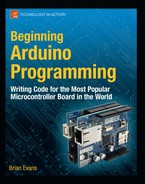Summary
That pretty much wraps up our cursory glance at some of the functions available to us from the SD library for reading and writing files to SD cards and with it our discussion of a few of the standard hardware libraries available on the Arduino platform. The hardware libraries are unique in that they are generally written for very specific types of hardware, devices, or chips. Instead of presenting a comprehensive description of every function for every piece of hardware that has a library, an exhausting and expensive venture to be sure, this chapter showed some of the wide-ranging capabilities available by using libraries and some of the more universal mechanics on how libraries work. Hopefully, you’ve picked up a least some of the hardware presented in this chapter and have had success with the circuits and code in our examples. You might even want to try out some of the other standard Arduino libraries or some of the many community-contributed libraries, now that you have a basic understanding of how they work.
We are now going to build on our discussion of libraries by looking at some of the serial libraries used to communicate with all sorts of different types of devices. We have already used some of the Serial functions in our code throughout this book, so it’s time to have a closer look and see how they work. There are also other forms of serial communication that we should look at, as well with their assorted advantages and disadvantages. These libraries are more generalized and work with a range of devices that support their protocol, so we shouldn’t need as much hardware for the next chapter.
